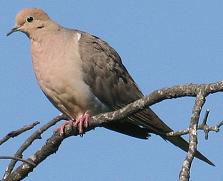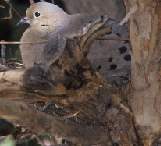 Mourning Dove Mourning Dove
Mourning Doves are one of the most wide
spread birds in North America. This makes them not only a
popular songbird but a game bird as well.
Identification and Pictures
| Mourning Doves (Zenaida Macrouraare) are
small slim doves about 12 inches. They are
fawn-colored with black spots on their backs and
pinkish-red feet and legs. Their distinctive long
pointed tail with large white outer tail feathers
stands out. Males have a slightly bluish crown and
nape, with a bit of pink on the breast.
Turtle doves are
sometimes mistaken for Morning doves.
|

Photo by Keith Lee. The camera I
use is the Canon
EOS 40D. |
When the birds fly they flap their wings
continually creating a whistle as the air passes through the
wing feathers. Just like other doves and pigeons this one
jerks its head with each step when it walks.
Get a Rock Dove puzzle.
Calls and Songs
Sometimes mistaken for an owl, the male's courtship and territorial call is a series of
cooing notes. It sounds like coah cooo cooo coo.
Both adults give a shorter call like oowa when near the nest.
There is also a whistling twitter when they take off.
Hear Mourning Dove Sound
Range and Habitat
In late fall mourning doves gather in large flocks across
nearly all of the United States, and southern Canada. Many,
but not all northern mourning doves migrate south in winter.
They can be found in grasslands, farmlands, open woods, and
roadsides. They are equally at home in backyards with
evergreens, fruit trees, and suburban gardens. In fact they
are at home in virtually any habitat. When you hear talk of a
bird for all seasons this is it.
Breeding and Nesting

Mourning doves breed in all 50 states,
southern Canada, Alaska, Mexico, and into Panama. Breeding
starts in March and April.
photo by Lee Karney U.S.
Wildlife
Courtship starts with the male cooing
call while puffing out his throat, and bobbing his tail. The
Fish and Wild Life Service actually counts them by listening
for this call. Another part of the courtship is the flight of
the male. He will fly to around 100 feet then glide back down
to the female in large sweeping circles. He will also strut
and bow repeatedly in front of the female. After mating the
male vigorously defends the nesting area. What is unusual is
the Morning doves will do most of their feeding outside the
nesting area.
The nesting site is often on a tree branch 10 to 25
feet up, and is chosen by the male. He then gathers sticks,
and bring them to the female, landing on her while she sits
on the partly built nest. Although they seem to take great
care, their nest is one of the flimsiest of all bird nests.
The eggs can even be seen through the twigs. Often they will
just use old nests from other birds such as robins.
 Usually
there are two white eggs with both birds taking turns on the
nest. Many nests are lost to bad weather. In addition
doves
have many predators such as squirrels, snakes, and other
birds. Both adults will feed the young, and they can leave the
nest in 10 to 14 days. Usually
there are two white eggs with both birds taking turns on the
nest. Many nests are lost to bad weather. In addition
doves
have many predators such as squirrels, snakes, and other
birds. Both adults will feed the young, and they can leave the
nest in 10 to 14 days.
They will have as many as six broods of two chicks each
during a season. This fast reproduction allows them to thrive
and spread even with high predation. Young birds leave the
nest in around two weeks and the parents continue to feed
them outside the nest for another two weeks.
Food and Feeding
Mourning doves natural foods are a wide
variety of wild seeds, grains, and insects. They often
feed on grain in open fields, and croplands. They will be seen
at feeders in larger numbers when the ground is covered in
deep snow.
Just as with other songbirds, food, water, and cover will
attract them to your backyard. Stock your feeders with
cracked corn, millet, and a variety of other seeds to attract
Mourning doves. Doves are ground feeders, so tray feeders are
best. While many songbirds will scatter when jays or
crows
arrive, Mourning doves will just ignore them and keep eating.
Water
Birdbaths will attract them, but running or dripping water
will draw more birds. You are also likely to get more birds
if you have trees, and shrubs for cover. I keep a water dish
on my deck rail, here is a video of turtle doves at the
dish.
For
other bird videos please visit our Youtube channel and
subscribe or like our videos.
Most videos on my site were taken with the Canon
HG10.
For more on food
and feeding click here.
For more on feeders click here.
 Dove posters
Dove posters
To learn about other favorite
birds click here.

|
